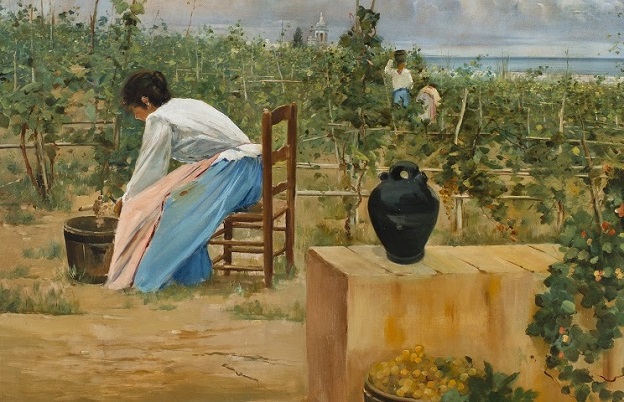In the Museum we sell Malmsey, both the sweet and the dry variety. We sell it because the owners of the company, the Llopis family, in later years donated their own house to the town of Sitges and their Malmsey business to the local hospital. Nowadays that house has been turned into a museum, the Romantic Museum and that hospital still has that winery as their income business, that vineyard belongs to the Hospital of Sitges, our main nursing home. Sitges used to live from farming and fishing before the shoe factories (yes) and later the well known touristic business we both are familiar with these days.
Malmsey is a wine that is made in Sitges. There are still a few vines left from the original plantations before we built hotels, many houses and apartments. During the 17th and 18th centuries, Malmsey was shipped overseas, to the colonies in America and also to Europe; it was a popular drink. Nowadays, due to fashion trends and the tendency that favours wines less sweet, with lower calorie intake. Still, if we drank a glass of Malmsey instead of feasting on some cake, sure we would stay trim.

It was a popular beverage in the times of 16th Century England mentioned in Shakespeare’s plays, in Love’s Labours Lost and Henry IV Part 2. But, its most shady mention is in Richard III: Richard orders the execution of his brother The Duke of Clarence, who had plotted against him with the Lancastrians, and there’s a mythical scene of a drowning rehearsed in the play. When the assassins hatch a plan to sink the Duke in a butt of this wine: “Take him on the costard with the hilts of thy sword and then throw him into the malmsey-butt in the next room”.Already incarcerated in the Tower of London, Clarence innocently asks for a cup of wine, and one of the murderers responds: “You shall have wine enough, my lord, anon”.

Sitges, 1895
Oil on canvas
Museu de Maricel, Sitges. Fons Cau Ferrat
Some things never change, like the procedures to make wine or the cultivation of grapes. There is a nature to understand a vineyard, growers know that, and of course, they would never think of writing down their knowledge, growing vines is an intense, passionate task only available to the knowledgeable. So today I will hint a couple of down to earth facts:
How does a vineyard worker know it’s dark and time to go home? Because he can’t see the lanes between the vines, then it’s officially dark.
And how do you know that, although you can’t feel it and are unaware, there’s a slight breeze in the air? By the gentle motion of the leaves at the top of the woody plants.

Vines tell us what season we’re in; they are ever-changing. Autumn is the most beautiful time to see the tones of yellows, oranges and reds. It is fascinating. Depending on the type of grape; the leaves are one colour or the other; Malmsey is more a yellowy tone. The bare vines in winter are as cold as winter itself, then, spring turns the bare bushes into the greenest of hope, and now that the grapes are developing from tiny to edible size, it will be the end of a cycle. And we’re ending the cycle soon, at the end of summer.
Photo Credits
© Photographic Archive of the Consorci del Patrimoni de Sitges
© Photographic Archive of Susana Preston Raga, Sitges
Susana Preston, guide and visitors attention for Sitges Museums

Deixa un comentari